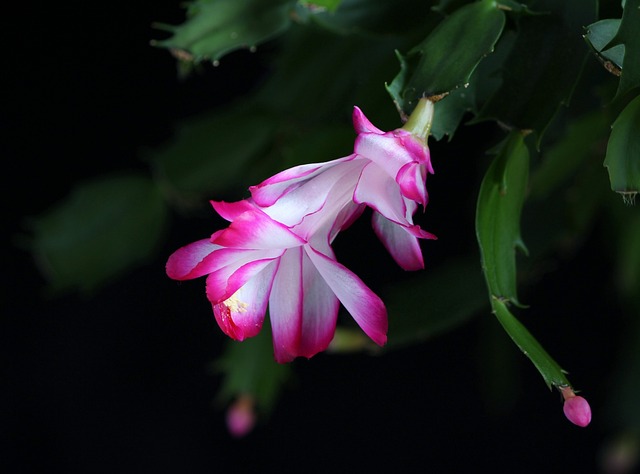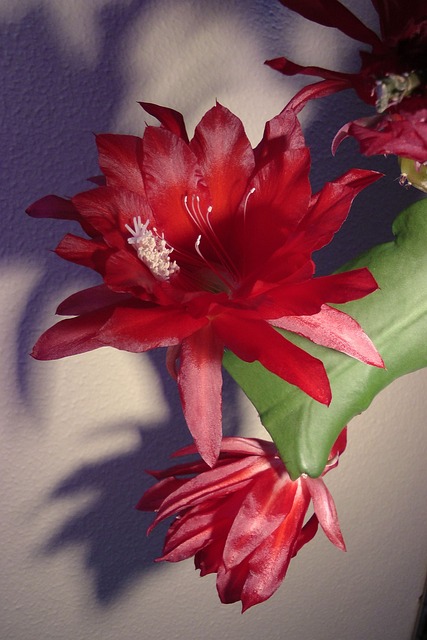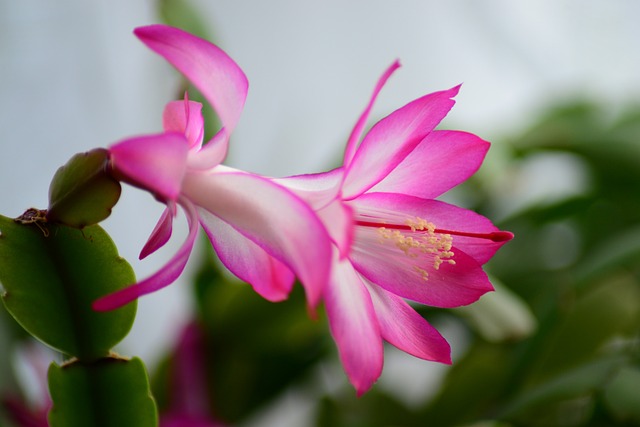Did you know that the Christmas cactus is a hybrid of the Thanksgiving and Easter cactus? The Thanksgiving cactus was the first species discovered in the forest of Brazil in 1817. Later in 1837, Charles Lemaire found the Easter cactus. He crossbred the two species that resulted in the first Christmas cactus in 1852. Today, hundreds of Christmas cactus hybrids exist. Christmas cactus has now become a popular indoor plant and a holiday gift.
What are the different types of Christmas cactus? The three types of Christmas cactus include the Thanksgiving cactus, Christmas cactus and Easter Cactus. Each type acquires distinct features that make them different from each other. Types refer to distinct species that have been identified by scientists.
As we learn the three main types of Christmas cactus, join us as we explore each type in this article.
Thanksgiving Cactus
We will discuss the first type of Christmas cactus – the Thanksgiving cactus. The Thanksgiving cactus is a native of Brazil’s rainforest which was discovered in 1817. Today, this type of Christmas cactus is a popular indoor plant that blooms during the fall and winter months. It’s also a low-maintenance plant. What makes this type different from the other Christmas cactus variety?

Key Characteristics of the Thanksgiving Cactus
Leaves – The Thanksgiving cactus has green spineless leaves that are flattened. These leaves possess pointed teeth that appear like a crab’s claws, the reason it is also known as the crab cactus. The Thanksgiving cactus leaves reach a mature size of 12 to 24 inches long.
Flowers – The flowers of the Thanksgiving cactus come in a variety of colors such as white, pink, orange or yellow. You’ll commonly see them in a dark shade of pink. Thanksgiving cactus flower once a year only. This cactus typically blooms mid-November or early December – that was where it derived its name. The flowers stay for as long as seven to eight weeks.
Related article: Can Christmas Cactus Survive Outside?
Easter Cactus
Another type of Christmas cactus is the Easter Cactus. It was also discovered in the forests of Brazil in 1832 and found growing on trees and rocks. The flowering season falls from March to May or right around Easter – where its name originated. Most people confuse this one with the Thanksgiving cactus, but they’re two completely different types. So how does this type of Christmas cactus differ from the other types?

Key Characteristics of the Easter Cactus
Leaves – Unlike the Thanksgiving cactus with crab-like edges in its leaves, the Easter cactus has rounded scallops on its flattened leaves. The presence of bristles and round margins found at the tip of the leaves make this distinct from the other types of Christmas cactus. The segments of the stem usually measure from 2 to 3 inches. The mature stems change from flattened to triangular in shape.
Flower – As mentioned, the Easter cactus blooms from March to May. The flower appears to be bell-shaped with a diameter that measures between 1.5 to 3 inches. The flower comes in a range of colors, such as pink, orange and red. Unlike the Thanksgiving cactus and Christmas cactus flowers, the Easter cactus flowers open during the day and close at night. These flowers last for as long as two weeks and reopen once the morning comes and closes again at night.
Christmas Cactus
The third type of Christmas cactus that we’re going to discuss is the Christmas cactus. You read it right – the Christmas cactus. To clarify your confusion, the Christmas cactus is just a general term given to a group of cacti that were discovered in the forest of southeastern Brazil. This group of cacti belongs to the genus of Schlumbergera – scientifically speaking. The Thanksgiving cactus is known as Schlumbergera truncata while the Easter cactus is Schlumbergera gaertneri.
The third type of cactus that we’re currently discussing is scientifically known as Schlumbergera x buckleyi or commonly known as the true Christmas cactus. As mentioned earlier, this type resulted from the crossbreed of the Thanksgiving cactus and the Easter cactus in 1852.

Key Characteristics of the Christmas Cactus
Leaves – True Christmas cactus consists of flattened segments with edges that are wider at the base and narrower at the tip – like a tear-drop shape. These edges have a series of small sharp teeth that makes it distinct from the other types. The tip of these leaves have areoles where flowers would appear.
Flower – Christmas cactus blooms from November to February. The flowers are asymmetrical and come in different colors such as purple to red. They have a tube-like appearance and droop downwards. This type of Christmas cactus blooms lasts for four to six weeks.
Caring for Christmas Cacti
Caring for these three types of holiday cacti is pretty much the same. In the next section, we will discuss the general care requirements for the following types.
Temperature
The temperature requirement for your Christmas cactus ranges between 70 to 80 degrees Fahrenheit. Although they are called cacti, they are not similar to the cactus in the desert that can tolerate intense drought. Christmas cacti thrive well in partially shaded locations.
Light
The Christmas cacti prefer bright but indirect light. Indoors, the ideal place to put the Christmas cactus is in front of the windows facing the east, north or west direction. Avoid the south windows because it’s too bright for the plant.
During winter months when there’s a scarcity of natural light, you can use artificial lights that emit full-spectrum lights. The light coming from full-spectrum lights will provide our Christmas cactus with the strong lighting it needs to grow and bloom. You can check this Full-Spectrum Light for plants indoors with great features such as dimmable levels, auto on and off timer and adjustable stand.
Water
The best way to water your Christmas cactus is to soak the soil until the water runs out of the pot drains. After that, allow the soil to completely dry before the next watering. During winter months, slightly water your Christmas cactus. A good interval would be from four to six weeks.
Related article: Best Pot for Christmas Cactus
Expert Tip:
Do not use cold water for your Christmas cactus because it can cause shock to the plant. Use lukewarm water. If you live in a humid climate, you may need to frequently water your Christmas cactus.
Fertilizer
Overfertilizing the Christmas cactus can be more harmful than underfertlizing it. If you apply fertilizer to your Christmas cactus, consider your plant’s size. Large Christmas cactus require stronger fertilizer than smaller ones. The interval of applying the fertilizer ranges between six to eight weeks. Don’t forget to water your plant after applying fertilizer.
Expert Tip:
Do not fertilize your Christmas cactus during winter months because they are dormant. When a plant is dormant, its growth halts. Applying fertilizer could lead to damage. Fertilizers contain nitrogen which leads to nitrogen toxicity. When a plant is in its dormant period, it slowly absorbs or stops absorbing nutrients and water. Symptoms include leaves turning yellow until they drop.
Pruning
The best time to prune Christmas cactus is after its blooming season – usually during summer or spring. Pruning plays an important part in your plant’s growth because it encourages new growth and flowering. It also promotes healthy plants as it is a good way to remove damaged or dead leaves.
Expert Tip:
In pruning your Christmas cactus, use a sterilized knife to avoid the spread of disease. I’d recommend the OTTO 4 Pack Professional Bypass Pruning Shears. They can help you with indoor and outdoor planting, and the handle design reduces the stress on your wrists making them perfect for older individuals who like plants.
Pests and Diseases
Christmas cactus is prone to pests and diseases that include:
- Root rot caused by fungi
- Spider mites
- Mealybugs
- Scale
Isolate your Christmas cactus when infected by any of these pests and diseases. The next step is to remove these pests from the infected parts of the plant. You can use insecticide or fungicide to treat your Christmas cactus. After treating your plant, make sure to take care of it well.
Related article: Ultimate Guide: Christmas Cactus Root Rot
Conclusion
Christmas cactus has three main types that include Thanksgiving cactus, Easter Cactus and Christmas Cactus. Each type acquires key characteristics that make them distinct from each other. The Thanksgiving cactus has crab-like leaves and flower colors that range from white to orange. Easter cactus has leaves with round and smooth edges with golden hair at the tip. The flowers usually appear in different colors such as pink and red. Lastly, the Christmas cactus possess leaves that have tear-drop shape edges and flowers that come in colors of red to purple.
Frequently Asked Questions
How Do I Know What Kind of Christmas Cactus I Have?
The easiest way to identify what kind of Christmas cactus you have is by looking at the leaves’ shape. The Thanksgiving cactus has leaves that look like a crab’s claw. The Christmas cactus has tear-drop shaped leaves. Easter Cactus has rounded leaves that have golden bristles at the tip.
What color is a healthy Christmas cactus?
A healthy Christmas cactus has vibrant dark green leaves that are firm when touched. The leaves are not yellow or wilted. If the leaves are yellowish, the Christmas cactus may be underwatered or overwatered. If the plant is wilted, it is underwatered.
What Is the Original Christmas Cactus?
The original Christmas cactus was recorded in 1854 and is a hybrid of the Thanksgiving cactus and the Easter cactus. It’s called the true Christmas cactus or scientifically known as Schlumbergera x buckleyi. This hybrid blooms in December and January.

